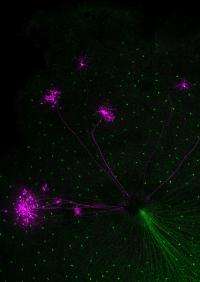How the eye builds circuits to detect motion

In a competitive scientific race, scientists from the Friedrich Miescher Institute for Biomedical Research (FMI) have been among the first to explain how the eye creates circuits to analyze motion. The detection of motion in the retina is based on circuit asymmetry, a fundamental computational principle in the brain. They showed that early after birth, nerve circuits in the retina go through a rapid transition from symmetric to asymmetric circuit states. This rapid switch is independent of visual inputs and likely to be genetically predetermined. Their results are published today on-line in Nature.
The brain works asymmetrically. Generally known is the fact that the left half of the brain performs different computations than the right half. But it does not end there, asymmetry is also found on a cellular level. Nerve cells in our eyes that react to movements from right to left are not active, when something moves from left to right and vice versa. Movement is only recorded in one direction. What is more, similar asymmetries are the basis for many brain computations. However, how and when this asymmetry develops was not known.
Neurobiologists from the Friedrich Miescher Institute for Biomedical Research of the Novartis Research Foundation have been able to describe for the first time in detail the development of asymmetry in the retina. Their results are published online today in Nature together with independently gained results from a group from the University of California, Berkeley. "Though we knew about the asymmetry in the retina and brain for half a century, it only became possible about 3 years ago - with the advent of new technologies - to gain mechanistic insights into how this is set up during development", commented Botond Roska, group leader at the FMI.
In the retina morphologically identical starburst amacrine neurons sit around a retinal ganglion cell like children in a circle around their teacher in the middle. The FMI scientists could show that at an early stage, all the amacrine cells connect to the ganglion cell and send their signal. The ganglion cell in turn reacts to all these inputs. Or, to extend the metaphor, it is as if all the children are talking simultaneously with the teacher in the middle, who is listening to all of them. But rather suddenly the circuit then switches behavior, and the ganglion cell reacts to only some of the amacrine neurons on one side, neglecting others on the other side. In the mouse, this shift happens between day 6 and day 8 after birth, at a time when the eyes of the mouse are still closed. This switch is selective for inhibitory synaptic signals rather than positive ones, but the molecular details still need to be disentangled
"Our findings indicate that asymmetry is not set up from the beginning, the circuit starts symmetrically and waits for a "switch signal" which initiates a transition to an asymmetric final state. How this process is controlled on a molecular level, we still need to figure out," said Roska.
More information: Yonehara K., et al. (2010) Spatially asymmetric reorganization of inhibition establishes a motion sensitive circuit. Nature dx.doi.org/10.1038/nature09711
















